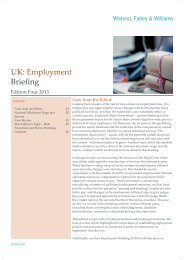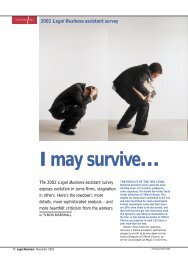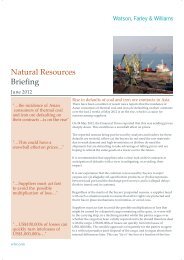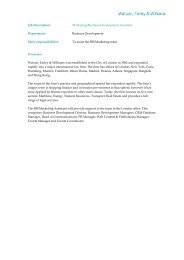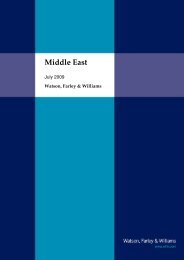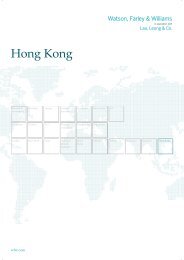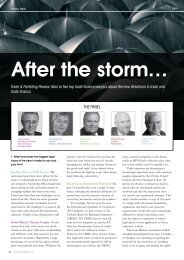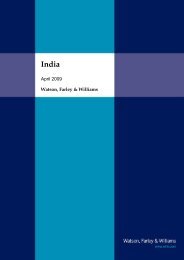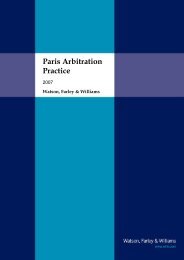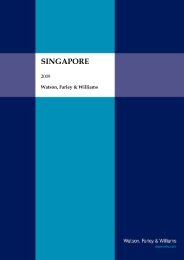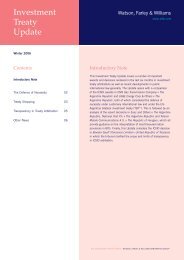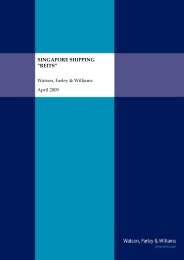Tax Avoidance - the Current UK Approach - Watson, Farley & Williams
Tax Avoidance - the Current UK Approach - Watson, Farley & Williams
Tax Avoidance - the Current UK Approach - Watson, Farley & Williams
Create successful ePaper yourself
Turn your PDF publications into a flip-book with our unique Google optimized e-Paper software.
Corporate tax feature from <strong>Watson</strong>, <strong>Farley</strong> & <strong>Williams</strong>published in <strong>the</strong> November 2011 issue of The In-House Lawyer:<strong>Tax</strong> avoidance: <strong>the</strong> current <strong>UK</strong> approach
CORPORATE TAX <strong>Watson</strong>, <strong>Farley</strong> & <strong>Williams</strong> LLP<strong>Tax</strong> avoidance: <strong>the</strong>current <strong>UK</strong> approachThe coalition government’s focus on combating tax leakage has made taxavoidance a topical issue and in recent years <strong>the</strong> courts have heard numerousanti-avoidance cases. Sarah Gatley clarifies <strong>the</strong> current position and outlinesregulatory plans for <strong>the</strong> futureIn <strong>the</strong> current economic climate, <strong>the</strong> <strong>UK</strong>government is keen to combat tax leakageand tax avoidance continues to be a topicalissue. <strong>Tax</strong> avoidance is increasingly reportedin <strong>the</strong> press following <strong>the</strong> emergence ofprotest groups, such as <strong>UK</strong> Uncut, which hasorganised action against companies that itconsiders to be involved in tax avoidance.There have been numerousanti-avoidance cases in recent years andthis article considers some of those casesand <strong>the</strong> approach taken by <strong>the</strong> <strong>UK</strong> courts totax avoidance. It also reviews HM Revenue& Customs’ and <strong>the</strong> government’s ongoingprogramme of reforms designed to tackle taxavoidance. The introduction of <strong>the</strong> Disclosureof <strong>Tax</strong> <strong>Avoidance</strong> Schemes regime hasaffected <strong>the</strong> way that HMRC deals with whatit perceives as tax avoidance, ensuring thatit is able to shut down offending schemespromptly. Fur<strong>the</strong>rmore, <strong>the</strong> governmentis actively considering <strong>the</strong> possibility ofimplementing a general anti-avoidancerule (GAAR), which in addition to variousongoing consultations on anti-avoidancelegislation, creates an uncertain and difficultenvironment for those wishing to organise<strong>the</strong>ir affairs in a tax-efficient manner.This article will not attempt to define taxavoidance, tax mitigation or tax evasion, asthose concepts would require an article to<strong>the</strong>mselves.DEVELOPMENT OF ANTI-AVOIDANCECASE LAWThe recent approach to dealing with taxavoidance by both HMRC and <strong>the</strong> courtshas provoked much discussion among taxpractitioners advising on tax mitigationarrangements. The courts have hearda raft of tax avoidance cases involvingvarious creative schemes, often with similarelements such as <strong>the</strong> circular movementof money, self-cancelling transactionsor <strong>the</strong> insertion of numerous steps thatseem to serve no commercial purpose,o<strong>the</strong>r than to secure a reduction in tax.Over <strong>the</strong> last 30 years, when consideringtax avoidance schemes, <strong>the</strong> approach takenby <strong>the</strong> courts has varied significantly, and<strong>the</strong>re often seems to be no consistencyin <strong>the</strong>ir approach. Consequently, <strong>the</strong> courts’attitude towards tax avoidance seemsuncertain.This article seeks to consider some of<strong>the</strong> more recent anti-avoidance cases – itis not intended to provide a detailed reviewof all anti-avoidance case law. Ra<strong>the</strong>r, thisarticle endeavours to highlight some of <strong>the</strong>differing approaches adopted by <strong>the</strong> courtstowards tax mitigation arrangements,while attempting to determine whe<strong>the</strong>ra cohesive judicial attitude towards taxavoidance is discernable.The cases discussed below all involvescenarios in which <strong>the</strong> judiciary has had toconsider <strong>the</strong> tax treatment applicable tovarious transactions designed to mitigate<strong>the</strong> effects of taxation. The circularmovement of money is a common threadin several of <strong>the</strong> cases, although <strong>the</strong>approach by <strong>the</strong> courts to dealing with taxavoidance varies and, it would seem, <strong>the</strong>circular movement of money is not alwaysfatal to <strong>the</strong> success of an arrangement.Commerciality of a transaction may alsobe important when considering whe<strong>the</strong>r atransaction is acceptable, although, againcommerciality alone is not always sufficientfor an arrangement to succeed.Prior to W T Ramsay Ltd v Inland RevenueCommissioners [1981] (discussed below), <strong>the</strong>courts adopted a more literal approach to<strong>the</strong> construction of legislation in <strong>the</strong> contextof tax-sensitive transactions. Consequently,<strong>the</strong> courts often refused attempts byHMRC to reclassify arrangements andremove <strong>the</strong> advantageous tax effects oftransactions structured to comply witha literal interpretation of <strong>the</strong> relevant taxlegislation, (see for example IRC v Duke ofWestminster [1936]). However, Ramsayheralded <strong>the</strong> beginning of a new approachto how <strong>the</strong> courts deal with cases involvingtax avoidance. Following Ramsay, <strong>the</strong> courtshave seemed more prepared to considerParliament’s intention when determining howtax legislation should be interpreted. Thishas enabled <strong>the</strong> judiciary both to reclassifytransactions according to <strong>the</strong>ir real legaleffect, for <strong>the</strong> purposes of applying <strong>the</strong>legislation to <strong>the</strong>m, and to interpret statutelaw having regard to its intended purpose.This has led to what some commentatorsrefer to as <strong>the</strong> judiciary’s ‘purposiveapproach’ to statutory interpretation.W T RAMSAY LTD v INLANDREVENUE COMMISSIONERS [1981]In this watershed case, <strong>the</strong> House of Lordsaccepted that in certain circumstances,www.inhouselawyer.co.ukNovember 2011 The In-House Lawyer 3
CORPORATE TAX <strong>Watson</strong>, <strong>Farley</strong> & <strong>Williams</strong> LLPdepending on <strong>the</strong> facts, it may beappropriate to recharacterise a transactionin order to eliminate unacceptable taxavoidance. In Ramsay, <strong>the</strong> taxpayercompany sought to create an allowable lossto offset against a chargeable gain it hadmade on a sale and leaseback transactionby using two loans. It sought to create <strong>the</strong>loss without actually suffering any financialdetriment, by entering into a series oftransactions whereby both a loss, whichwas allowable for tax purposes, and amatching gain, which was not chargeable totax, were created.In its judgment, <strong>the</strong> House of Lordsheld that <strong>the</strong> judiciary was not bound toconsider individual steps in a series oftransactions, where <strong>the</strong> steps were soclosely associated with each o<strong>the</strong>r as toform a single composite arrangement.When applying <strong>the</strong> tax legislation to <strong>the</strong>facts in such circumstances, <strong>the</strong> courtswere entitled to have regard to <strong>the</strong> effectof <strong>the</strong> transactions as a whole and werenot bound to have regard to individualcomponents of <strong>the</strong> arrangements. Inparticular, Lord Wilberforce confirmed that<strong>the</strong> courts were not confined to adoptinga literal interpretation of tax legislation.However, it should be noted that Lord Fraserof Tullybelton expressly confirmed that hewas not suggesting that <strong>the</strong> legal form of atransaction should be disregarded in favourof its supposed substance.Following Ramsay, where tax avoidancearrangements have involved artificial stepsdesigned to enable such arrangementsto fall within <strong>the</strong> ambit of particular taxlegislation, <strong>the</strong> courts have demonstrateda willingness to disregard such artificialsteps and recharacterise <strong>the</strong> arrangementsby considering <strong>the</strong> reality and effect of <strong>the</strong>arrangements as a whole. Consequently,transactions that have been motivated by<strong>the</strong> desire to avoid tax, that involve artificialsteps, have increasingly found <strong>the</strong>mselvesvulnerable to reclassification when <strong>the</strong>courts have considered <strong>the</strong> legal effect of<strong>the</strong> composite transaction. However, this isnot always <strong>the</strong> case.The approach taken in Ramsay hasbeen adopted in numerous anti-avoidancecases and commentators often refer toRamsay as having developed <strong>the</strong> doctrineof a ‘purposive approach’ to interpretingtax legislation. However, subsequentcases have confirmed that <strong>the</strong>re is no suchconcept as <strong>the</strong> ‘Ramsay doctrine’.Some of <strong>the</strong> notable anti-avoidance casesthat followed Ramsay are highlighted below.FURNISS v DAWSON [1984]A family attempted to defer a capital gainarising on <strong>the</strong> disposal of <strong>the</strong>ir companyby means of various steps involvingexchanging <strong>the</strong> shares prior to <strong>the</strong> disposal.The court considered that <strong>the</strong> transactionsshould be treated as a single compositetransaction and <strong>the</strong> scheme failed.ENSIGN TANKERS LEASINGLTD v STOKES [1992]This case concerned a claim for capitalallowances in respect of expenditure thatwas incurred by a limited partnership setup to finance films. The limited partnershipcontributed approximately £3m and <strong>the</strong>balance of approximately £11m wasfinanced by means of limited recourse loans.Capital allowances were claimed on £14m.The case considered what ‘incurred’ meant.In adopting a purposive approach to <strong>the</strong>legislation <strong>the</strong> House of Lords held that<strong>the</strong> partners were only entitled to capitalallowances on <strong>the</strong> money that <strong>the</strong>y hadactually expended and not on <strong>the</strong> full £14m.One of <strong>the</strong> key issues in Ensign was <strong>the</strong>circularity of monies.MACNIVEN v WESTMORELANDINVESTMENTS LTD [2001]This was a House of Lords decision in which<strong>the</strong> taxpayer was successful. The caseinvolved a property holding company thatwas suffering from financial difficultiesand which accepted loans from its majorshareholder, a pension fund. The companycould not repay <strong>the</strong> loans, and consequently<strong>the</strong> pension fund made fur<strong>the</strong>r interest-freeloans, which were immediately used to repay<strong>the</strong> accrued interest to <strong>the</strong> pension fundon <strong>the</strong> earlier loans. It claimed that <strong>the</strong>sepayments should be treated as chargeson income. HMRC sought to argue that<strong>the</strong> interest had not been paid. The Courtconsidered whe<strong>the</strong>r <strong>the</strong> payment had <strong>the</strong>effect <strong>the</strong> taxpayer intended or whe<strong>the</strong>r,due to <strong>the</strong> circularity of <strong>the</strong> payments, andby reviewing <strong>the</strong> transaction as a whole <strong>the</strong>interest should not be treated as havingbeen paid.BARCLAYS MERCANTILE BUSINESSFINANCE (BMBF) v MAWSON [2004]This case represented ano<strong>the</strong>r victory for<strong>the</strong> taxpayer (although HMRC won at firstinstance), with which those readers in <strong>the</strong>finance leasing industry may be familiar.BMBF purchased a gas pipeline under <strong>the</strong>Irish sea from <strong>the</strong> Irish Gas Board (BGE) andleased it back to BGE. BGE subleased <strong>the</strong>pipeline to its wholly owned subsidiary,which assumed direct liability to BMBFto pay <strong>the</strong> rent due under <strong>the</strong> headlease.BGE’s obligations to BMBF were secured bya deposit with BMBF’s parent. The depositwas indirectly sourced by <strong>the</strong> £91m receivedfrom BMBF for <strong>the</strong> purchase of <strong>the</strong> pipeline.BMBF had borrowed £91m, with which it paidfor <strong>the</strong> pipeline, from Barclays Bank.HMRC argued that <strong>the</strong> transactioninvolved <strong>the</strong> circular movement of moneyand that when <strong>the</strong> legislation wasinterpreted as Parliament intended it toapply, no allowances should be granted.Following <strong>the</strong> earlier Court of Appealdecision, <strong>the</strong> House of Lords rejectedHMRC’s arguments and, in interpreting <strong>the</strong>relevant legislation, concluded that <strong>the</strong>requirements of <strong>the</strong> Capital AllowancesAct 1990 were met and that <strong>the</strong> companywas entitled to <strong>the</strong> full capital allowances.In reaching its decision, <strong>the</strong> House ofLords highlighted <strong>the</strong> importance ofstatutory interpretation and of carryingout a thorough analysis of <strong>the</strong> relevant taxlegislation. In BMBF, <strong>the</strong> Court held that <strong>the</strong>transactions complied with <strong>the</strong> relevantstatutory provisions and <strong>the</strong>refore, fur<strong>the</strong>ranalysis was not required.BMBF is also important because <strong>the</strong>House of Lords considered that <strong>the</strong>circularity of money in <strong>the</strong> transactionwas irrelevant when determining how <strong>the</strong>provision of <strong>the</strong> legislation in question shouldbe construed. However, subsequent caseshave not always ignored <strong>the</strong> circularityof money when interpreting legislationaccording to Parliament’s intentions.ASTALL & ANOR v HM REVENUEAND CUSTOMS [2009]In this case involving an individual, <strong>the</strong>court found in favour of HMRC. It providesa useful example of how <strong>the</strong> courtshave moved away from <strong>the</strong> narrow rulesof statutory construction when thatapproach to interpretation would producean unacceptable result and alternatively,have chosen to adopt a more purposiveapproach to interpreting tax legislation.While <strong>the</strong> courts’ approach in such casesis interesting, it is not helpful to taxpayersseeking clarity.4 The In-House Lawyer November 2011www.inhouselawyer.co.uk
CORPORATE TAX <strong>Watson</strong>, <strong>Farley</strong> & <strong>Williams</strong> LLPTOWER MCASHBACK LLP 1 & ANORv REVENUE AND CUSTOMSCOMMISSIONERS [2011]This was ano<strong>the</strong>r decision that involvedcircular movements of money with <strong>the</strong> aim ofclaiming capital allowances and was decidedin HMRC’s favour. The Supreme Court heldthat although capital expenditure wasincurred, only some of it was attributableto plant and machinery. The remainingexpenditure was part of a payment loopdesigned to inflate <strong>the</strong> allowances beingclaimed, which did not have any real linkwith <strong>the</strong> plant and machinery acquired.Accordingly, only part of <strong>the</strong> expenditurequalified for capital allowances.The Supreme Court adopted a similarapproach to Ramsay and confirmed thatMawson and Ensign Tankers are still good law.MAYES v REVENUE AND CUSTOMSCOMMISSIONERS [2011]This case represented ano<strong>the</strong>r taxpayervictory. Mr Mayes was one of a number ofparticipants in a tax avoidance schemeknown as SHIPS2. The participants in <strong>the</strong>scheme were all <strong>UK</strong>-resident taxpayers withhigh earnings or significant capital gains. Thepurpose of <strong>the</strong> scheme was to minimise <strong>the</strong>tax liabilities of <strong>the</strong> participants. The schemeinvolved <strong>the</strong> taxpayers purchasing secondhandlife assurance policies and surrendering<strong>the</strong>m in order to obtain a deduction forincome tax and capital gains tax purposes.The scheme depended on <strong>the</strong>implementation of seven pre-determinedsteps. HMRC accepted that all <strong>the</strong> stepswere genuine, but argued that steps threeand four, when applying <strong>the</strong> legislation,should be ignored, on <strong>the</strong> basis that <strong>the</strong>yconstituted a singly, wholly self-cancelling,pre-planned transaction for tax avoidancepurposes which had no commercial purpose.Following conflicting decisions by both <strong>the</strong>Special Commissioners and <strong>the</strong> High Court,<strong>the</strong> Court of Appeal dismissed HMRC’s appealand held that <strong>the</strong> High Court was correct toallow Mr Mayes’ claim for relief.Of all <strong>the</strong> recent cases, <strong>the</strong> decisionin Mayes is perhaps <strong>the</strong> most difficult toreconcile with <strong>the</strong> cases that have gonebefore it.DEUTSCHE BANK GROUP SERVICES(<strong>UK</strong>) LTD v HM REVENUE & CUSTOMSCOMMISSIONERS [2011]This First Tier Tribunal decision was heardalongside <strong>the</strong> case of UBS AG v HM Revenue‘Of all <strong>the</strong> recent cases, <strong>the</strong> decision in Mayes vRevenue and Customs Commissioners [2011] is perhaps<strong>the</strong> most difficult to reconcile with <strong>the</strong> cases that havegone before it.’& Customers Commissioners [2010], which fall within certain widely drawn descriptionsraised similar issues. Both cases involved (known as hallmarks). The aim of <strong>the</strong> regimea scheme to pay bonuses in <strong>the</strong> form of is to provide HMRC with information aboutrestricted shares, which aimed to avoid potential tax avoidance arrangements at antax and national insurance contributions. earlier stage than previously and has beenIn applying a purposive interpretation to and continues to be effective in enabling<strong>the</strong> legislation, <strong>the</strong> First Tier Tribunal found HMRC to expedite <strong>the</strong> process of shuttingthat <strong>the</strong> legislation did not apply and so <strong>the</strong> down and preventing arrangements itscheme failed.considers unacceptable tax avoidance.On 22 June 2011, HMRC issued anAND MOST RECENTLY…informal consultation paper, whichTwo of <strong>the</strong> most recently reportedproposes changes to <strong>the</strong> DOTAS ‘hallmarks’anti-avoidance cases include Explainaway applicable to <strong>the</strong> disclosure rules relatingLtd & ors v Revenue & Customs [2011] to direct taxes. Comments were invitedand Schofield v HMRC [2011], <strong>the</strong> latter of by 31 August 2011. The paper focuseswhich involved a capital gains tax avoidance on three key areas: employment incomescheme. The Upper Tribunal confirmed that schemes, offshore schemes and lossfour option contracts forming part of <strong>the</strong> schemes. With respect to employmentavoidance scheme constituted a single, income schemes and offshore schemes,composite transaction and so <strong>the</strong> scheme <strong>the</strong> paper considers <strong>the</strong> introduction of afailed to achieve <strong>the</strong> desired tax advantage. new hallmark. With regard to loss schemes,Akin to earlier case law, <strong>the</strong> Upper Tribunal <strong>the</strong> paper considers widening <strong>the</strong> existingapplied existing case law, to disallow <strong>the</strong> loss hallmark, as it views <strong>the</strong> existing onescheme on <strong>the</strong> basis of <strong>the</strong> circularity of <strong>the</strong> as too narrow.transaction. The Tribunal focused on <strong>the</strong> Being an informal consultationultimate outcome of <strong>the</strong> scheme, <strong>the</strong>refore document, it does not outline <strong>the</strong> proposalsmaking it more difficult for taxpayers in any detail. However, it does signal HMRC’scontemplating such schemes to avoid a intention to bolster and extend <strong>the</strong> DOTASchallenge by HMRC by contriving to design regime, which it hopes will ultimately detera tax avoidance scheme to appear more users of such schemes.commercial.The courts have shown a willingness CODE OF PRACTICE ONto consider Parliament’s intention when TAXATION FOR BANKSdetermining how <strong>the</strong> tax legislation should On 9 December 2009, following abe interpreted in cases involving taxconsultation process, <strong>the</strong> governmentavoidance. However, <strong>the</strong> approach taken published a Code of Practice on <strong>Tax</strong>ationby <strong>the</strong> courts is not always consistent, for Banks (<strong>the</strong> Code). The Code stateswhich makes tax planning for legitimate tax that banks can undertake tax planningmitigation both complicated and uncertain. to support <strong>the</strong>ir business operations, butthis should not be used to achieve taxTHE DISCLOSURE OF TAXresults that are contrary to <strong>the</strong> intentionsAVOIDANCE SCHEMES (DOTAS)of Parliament. Paragraph 2.2 of <strong>the</strong>The DOTAS regime was introduced in 2004 Code requires <strong>the</strong> bank to have a formaland requires promoters, and in some cases, documented strategy and governanceusers, of certain tax planning schemes process for taxation matters. The boardto notify HMRC of <strong>the</strong> arrangements or of directors or a senior person will beproposals. Schemes are notifiable if <strong>the</strong>y responsible for <strong>the</strong> policy being followed.www.inhouselawyer.co.ukNovember 2011 The In-House Lawyer 5
CORPORATE TAX <strong>Watson</strong>, <strong>Farley</strong> & <strong>Williams</strong> LLP‘The government intends to take a more strategicapproach to dealing with tax avoidance and has outlinedan “ambitious” package of measures designed to dealwith tax avoidance.’Paragraph 3 states that:HMRC’s new strategy has generally beenmet with support from <strong>the</strong> tax profession.‘… <strong>the</strong> bank should not engage in taxplanning o<strong>the</strong>r than that which supports CONSULTATION DOCUMENT ‘HIGH RISKgenuine commercial activity’.TAX AVOIDANCE SCHEMES’In May 2011, following <strong>the</strong> proposals outlinedParagraph 3.3 states that:in <strong>the</strong> aforementioned document on tacklingtax avoidance, HMRC published a consultation‘… remuneration packages for bank document entitled ‘High Risk <strong>Tax</strong> <strong>Avoidance</strong>employees, including senior executives, Schemes’. Comments were due by 31should be structured so that <strong>the</strong> bank August 2011. In this document, HMRC detailsreasonably believes that <strong>the</strong> proper proposals to introduce legislation to removeamounts of tax and national insurance <strong>the</strong> cash-flow benefits from those who usecontributions are paid on <strong>the</strong> rewards of high-risk tax avoidance schemes. Accordingemployment’.to <strong>the</strong> consultation document, a high-risk taxavoidance scheme is one that uses contrivedIt is possible that <strong>the</strong> publication of <strong>the</strong> arrangements to seek tax advantages inCode will dissuade banks from attempting circumstances where <strong>the</strong>y are not intendedto implement aggressive tax avoidance to be available and which HMRC believes doesschemes, particularly with respect to <strong>the</strong> not deliver <strong>the</strong> advertised tax advantages.remuneration of employees.This concept reflects judicial decisions intax avoidance cases. It is proposed thatGOVERNMENT PAPER FOR<strong>the</strong> legislation will list specific high-riskTACKLING TAX AVOIDANCEtax avoidance schemes, so that certainAs part of <strong>the</strong> 2011 Budget, <strong>the</strong>consequences can be attached to usinggovernment published a document entitled those schemes. Those using a listed scheme‘Tackling <strong>Tax</strong> <strong>Avoidance</strong>’, which explains would be required to report its use to HMRC.that <strong>the</strong> government intends to take aThe government wants to ensure thatmore strategic approach to dealing with tax a person who uses a listed scheme thatavoidance. The paper outlines an ‘ambitious’ does not work is not better off financiallypackage of measures to deal with <strong>the</strong> issue, than a person who does not use this typeincluding a new anti-avoidance strategy, of scheme. It is intended that this will<strong>the</strong> first announcements of reviews in be achieved by removing <strong>the</strong> cash-flowhigh-risk areas of <strong>the</strong> tax system, options to advantage of using such schemes. Thereduce <strong>the</strong> cash-flow advantage from using cash-flow advantage will be removed byavoidance schemes and targeted responses providing that users of such schemes will beto specific avoidance risks.subject to an additional charge on amountsHMRC’s new anti-avoidance strategy will that are underpaid. This charge can befocus on three core elements:avoided by users paying any disputed taxupfront. The additional charge will be set1) preventing avoidance at <strong>the</strong> outset at a rate that will remove <strong>the</strong> cash-flowwhere possible;advantage of not paying <strong>the</strong> tax upfront.2) detecting it early where it persists; and CONSULTATION ON TAX TREATY AVOIDANCEAt <strong>the</strong> 2011 Budget, <strong>the</strong> government3) countering it effectively throughannounced its intention to introducechallenge by HMRC.legislation in <strong>the</strong> Finance Bill 2012 to countertax avoidance schemes that exploit <strong>the</strong>provisions of double taxation agreements(DTA). Accordingly, on 1 August 2011, HMRCpublished a consultation and draft legislationon tax treaties anti-avoidance. The purposeof <strong>the</strong> draft legislation was to ensure thatindividuals, companies and o<strong>the</strong>r personscannot benefit from <strong>the</strong> provisions of a DTAwhere <strong>the</strong> claim to such benefit is part ofan arrangement whose main purpose is toreduce a liability to <strong>UK</strong> taxation. However,on 9 September 2011, <strong>the</strong> government,prior to <strong>the</strong> consultation period ending,announced that it had decided to dropits proposed legislation as a result of <strong>the</strong>responses it had received to consultation.Following <strong>the</strong> withdrawal, <strong>the</strong> ExchequerSecretary to <strong>the</strong> Treasury, David Gaukeissued a written ministerial statement inwhich he explained that <strong>the</strong> responses sofar received ‘have made it clear that <strong>the</strong>proposed legislation, as drafted, could causesignificant uncertainty for compliant <strong>UK</strong>businesses and overseas investors about itsintended scope and its practical effect.’ Thestatement does not rule out fur<strong>the</strong>r actionin this area, although at this stage, given <strong>the</strong>Astall & Anor v Revenue and Customs[2009] EWCA Civ 1010Barclays Mercantile Business Finance(BMBF) v Mawson [2004] <strong>UK</strong>HL 51Deutsche Bank Group Services (<strong>UK</strong>) Ltd vHM Revenue & Customs Commissioners[2011] <strong>UK</strong>FTT 66 (TC)Ensign Tankers Leasing Ltd v Stokes[1992] 1 AC 655Explainaway Ltd & Ors v Revenue &Customs [2011] <strong>UK</strong>FTT 414 (TC)Furniss v Dawson [1984] 55 TC 324IRC v Duke of Westminster [1936] AC 1 HLMacNiven v Westmoreland InvestmentsLtd [2001] <strong>UK</strong>HL 6Mayes v Revenue and CustomsCommissioners [2011] EWCA Civ 407Schofield v HMRC [2011] <strong>UK</strong>UT 306 (TC)Tower MCashback LLP 1 & anor v Revenueand Customs Commissioners [2011] STC1143UBS AG v HM Revenue & CustomersCommissioners [2010] <strong>UK</strong>FTT 366 (TC),W T Ramsay Ltd v Inland RevenueCommissioners [1981] STC 1746 The In-House Lawyer November 2011www.inhouselawyer.co.uk
CORPORATE TAX <strong>Watson</strong>, <strong>Farley</strong> & <strong>Williams</strong> LLPresponses and <strong>the</strong> difficulty of introducing it,such legislation is unlikely.INTRODUCTION OF A GAARIn December 2010, <strong>the</strong> governmentasked Graham Aaronson QC, a leading taxbarrister, to chair a study programme into<strong>the</strong> introduction of a GAAR. The study groupis considering whe<strong>the</strong>r a GAAR is possibleand if so, <strong>the</strong> form that it would take.In June 2011, HMRC published aprogress summary compiled by <strong>the</strong>study group setting out its progress todate. In its progress summary, <strong>the</strong> studygroup noted that it has considered andreached a consensus on <strong>the</strong> strengths andweaknesses of <strong>the</strong> current judicial approachto <strong>the</strong> interpretation of tax statutes and<strong>the</strong> application of those statutes to taxavoidance schemes.According to <strong>the</strong> progress summary,<strong>the</strong> study group has reached consensuson what would be <strong>the</strong> potential advantagesof a GAAR for <strong>the</strong> <strong>UK</strong>, and what concernsa GAAR would need to address andallay. The work done by <strong>the</strong> study grouphas enabled it to develop a contractualframework of principles that would need tobe embodied in a GAAR, which could<strong>the</strong>n be enacted.The study group will now considerwhe<strong>the</strong>r it is possible to develop fur<strong>the</strong>r<strong>the</strong> framework it has produced into a set ofstatutory rules. Consequently, it currentlyremains uncertain whe<strong>the</strong>r a GAAR will beimplemented. The study group is due todeliver its final report by 31 October 2011,so it will shortly be known whe<strong>the</strong>r <strong>the</strong>study group considers that a GAAR can, andshould, be developed and <strong>the</strong>n enacted.It should be noted that GAARs alreadyexist in most European jurisdictions and inCanada, New Zealand and Australia, withvarying degrees of success. Each of <strong>the</strong>seGAARs have <strong>the</strong>ir own characteristics,some with clearance systems. To date, ithas not been decided whe<strong>the</strong>r any GAARthat is introduced in <strong>the</strong> <strong>UK</strong> would have aclearance system.At this stage, it is difficult to predict <strong>the</strong>form a GAAR would take and its practicaleffect. It may be that by having a GAAR, taxlegislation could be simplified. In recent years<strong>the</strong>re has been a trend for governments toenact emergency legislation to close downtax avoidance loopholes. This action hasresulted in a raft of complicated and oftenill-thought out anti-avoidance provisions intax legislation. It is arguable that a GAARcould provide a simplified anti-avoidancemechanism, which would avoid <strong>the</strong> need forcomplicated emergency legislation.There have been discussions of <strong>the</strong>GAAR taking a principles-based approach.That has <strong>the</strong> advantage of beingall-encompassing, but may result incontinuing uncertainty. A more prescriptiveGAAR, although creating greater certaintyfor taxpayers, may not have <strong>the</strong> desiredeffect of deterring those intent oncircumventing <strong>the</strong> tax system. Whateverapproach is taken, it is hoped that a GAARwill provide certainty and will not merelybe an additional power enabling HMRC tointimidate taxpayers.SUMMARYRamsay heralded <strong>the</strong> start of a new approachto <strong>the</strong> way <strong>the</strong> courts deal with casesinvolving tax avoidance. Following Ramsay, <strong>the</strong>courts have shown a willingness to considerParliament’s intention when determining howtax legislation should be applied.There have been numerous casesinvolving tax avoidance, some withsurprising outcomes, and as a result, <strong>the</strong>approach <strong>the</strong> courts will take is not alwaysclear. The introduction of a GAAR may, it ishoped, increase certainty for taxpayers byproviding a clear framework for tax planning.Outside of <strong>the</strong> courts, <strong>the</strong>re are numerousconsultation documents on anti-avoidance,and all of <strong>the</strong>se factors make for an uncertainenvironment for those seeking to undertaketax mitigation arrangements.By Sarah Gatley, solicitor,<strong>Watson</strong>, <strong>Farley</strong> & <strong>Williams</strong> LLP .E-mail: sgatley@wfw.com.www.inhouselawyer.co.ukNovember 2011 The In-House Lawyer 7



